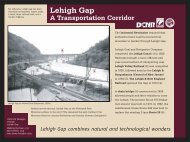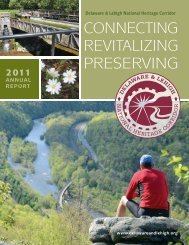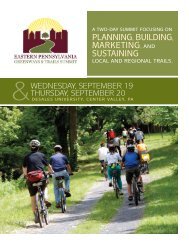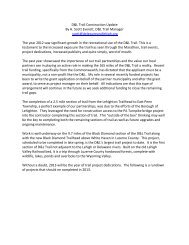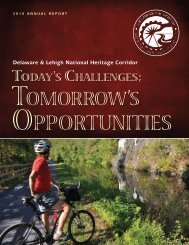download the full guide - Lehigh Gap Nature Center
download the full guide - Lehigh Gap Nature Center
download the full guide - Lehigh Gap Nature Center
- No tags were found...
You also want an ePaper? Increase the reach of your titles
YUMPU automatically turns print PDFs into web optimized ePapers that Google loves.
Eastern Bluebird17“Today, it’s still possible to walk <strong>the</strong> same paths,and see many of <strong>the</strong> same species, that <strong>the</strong>giants of early American ornithology saw.”History has flowed, just as have <strong>the</strong> rivers thatframe eastern Pennsylvania. Few parts of <strong>the</strong>state have been hit as hard by development– yet <strong>the</strong> birding opportunities here remainrich. Stretching from <strong>the</strong> tidal marshes of<strong>the</strong> lower Delaware, through <strong>the</strong> Piedmontfarmland to <strong>the</strong> extensive forests of <strong>the</strong> ridgeand-valleysystem and <strong>the</strong> cool, conifer-lacedbogs of <strong>the</strong> Pocono plateau, it’s a region ofvaried topography and habitat, and thus greatfor birds.It’s also a region which, despite its largehuman population, still has a lot of publicland that’s open for birding, from state parkslike Hickory Run and <strong>Lehigh</strong> Gorge in CarbonCounty, to state forests and natural areas likeBruce Lake in Pike County and Brady’s Lakein Monroe, as well as tens of thousands ofacres of state game lands, local and countyparks. The region also has an unusual numberof private preserves like Hawk Mountain, <strong>the</strong><strong>Lehigh</strong> <strong>Gap</strong> <strong>Nature</strong> <strong>Center</strong> and TannersvilleCranberry Bog Preserve.Today, it’s still possible to walk <strong>the</strong> same paths,and see many of <strong>the</strong> same species, that <strong>the</strong>giants of early American ornithology saw,whe<strong>the</strong>r it’s spring migrants filling <strong>the</strong> old treesat Bartram’s Garden, or <strong>the</strong> eastern phoebesthat still nest along Perkiomen Creek at MillGrove, where Audubon tied silver wires to <strong>the</strong>irlegs to prove that <strong>the</strong> same phoebes came backto nest each spring – <strong>the</strong> first crude attempt atbird-banding.You can chase Audubon’s ghost through <strong>the</strong>“Shades of Death” on <strong>the</strong> upper <strong>Lehigh</strong>, wherenor<strong>the</strong>rn warblers still abound, and whereravens have returned after a century’s absence– and if <strong>the</strong> passenger pigeons that once drankfrom <strong>the</strong> Schuylkill are just a memory, <strong>the</strong>sting is eased by resurgent peregrine falcons,nesting in Allentown, Reading and on <strong>the</strong> cliffsof <strong>the</strong> Delaware Water <strong>Gap</strong>, or bald eaglesin growing numbers throughout <strong>the</strong> region.Everywhere you look in eastern Pennsylvania,you’ll find birds. All you need is time,binoculars – and this <strong>guide</strong>, of course.



